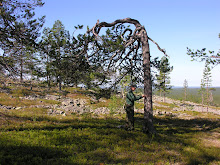In April, Lauri described a typical week in office and lunch as the highlight of a day. I guess this is how many of our days are, nothing too much happening. Fortunately, there are also times when I wish I would have just one ordinary day in office to take care of this and that - the normal, boring days in office are after all something I enjoy.
I spent most of May and June in Helsinki, and it proved to be time for flying from one place to another - no time for sitting in the office and staring at my computer screen. There were two main reasons for this: the PHYSENSE workshop we were organizing in Helsinki and the Solemn Conferment ceremonies of our Faculty (and all the preparations related to both of them).
The PHYSENSE workshop was the second one we organized, so there was a certain routine to it already. Things went smoothly, and at least I enjoyed the workshop and meeting friends once again.
The
Solemn Conferment ceremonies at our Faculty are arranged every six years and last for three days including two formal dinners, the Conferment, a grand ball and a countryside picnic. The dress code for all the events is very strict, and takes some time (and effort) to fulfill. Through May, we also practiced old academic dances such as Krakowiak, Valse Mignon, Cicapo and Pas d'Espagne. However, for me, the toughest part was preparing my two (trilingual) speeches for the Solemn Conferment. I know it is the daily job of many people to make formal speeches for big audiences, but for a regular postdoc like me it is certainly a task out of the ordinary. I spent two weeks before the ceremonies simply being nervous...
During the Solemn Conferment, a special reason for joy for our research group was that Tiit Nilson was appointed as an honorary doctor in our Faculty - a beautiful way to acknowledge his long collaboration with the Finnish forest research community.
Recovering from the Solemn Conferment (and the four hours of sleep per night we were able to catch) took me several days. I can honestly admit that I was sleeping in front of my screen, not just staring at it.
A few days after the celebrations Yuri Knyazikhin came for a visit. It was very nice seeing him again, and hearing about future research plans and planning collaboration. In our mini-seminar (i.e. Yuri, Pola, Matti, me) Yuri presented his ideas which involved (surprise, surprise!) our favorite spectral invariants, and Matti presented his new algorithm for retrieving leaf albedo from hyperspectral RS data.
After waving goodbye to Yuri, it was the time for me to say goodbye to Helsinki and head for Tartu (and summer vacation!). Ordinary office days are getting closer...

Conferment picnic (by Matti)




 Finnish larch going strong in the middle of the North-Atlantic
Finnish larch going strong in the middle of the North-Atlantic




 Never let someone else choose your plot locations!
Never let someone else choose your plot locations! Field assistant establishing LAI-plot
Field assistant establishing LAI-plot


